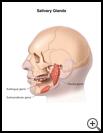
Parotid Gland Removal (Parotidectomy)
________________________________________________________________________
KEY POINTS
- A parotidectomy is surgery to remove a parotid gland. You have a parotid gland in each cheek that makes saliva.
- Every procedure or treatment has risks. Ask your healthcare provider which risks apply to you.
- Ask your provider when you can return to your normal activities and how to take care of yourself at home.
________________________________________________________________________
What is a parotidectomy?
A parotidectomy is surgery to remove a parotid gland.
You have a parotid gland in each cheek just in front of and slightly below your ears. These glands make saliva.
This surgery may be done to remove a lump in the gland, or it may help prevent or treat other problems caused by a growth or stones in the gland. For example, sometimes chemicals in your saliva can harden and cause stones to form. The stones can block saliva and keep it from getting into your mouth. This can cause pain and swelling of the gland and a dry mouth.
When is it used?
Your healthcare provider may recommend removing a parotid gland because:
- The parotid gland has a lump. If the lump is cancer, the gland may need to be removed to cure the cancer and keep it from spreading. Even if the lump is not cancer, it may still need to be removed so if it gets bigger.
- You have pain and swelling from stones in the gland, or stones have damaged the gland.
Ask your healthcare provider about your choices for treatment and the risks.
How do I prepare for this procedure?
- Make plans for your care and recovery after you have the procedure. Find someone to give you a ride home after the procedure. Allow for time to rest and try to find other people to help with your day-to-day tasks while you recover.
- Follow your provider's instructions about not smoking before and after the procedure. Smokers may have more breathing problems during the procedure and heal more slowly. It is best to quit 6 to 8 weeks before surgery.
- You may or may not need to take your regular medicines the day of the procedure. Tell your healthcare provider about all medicines and supplements that you take. Some products may increase your risk of side effects. Ask your healthcare provider if you need to avoid taking any medicine or supplements before the procedure.
- Tell your healthcare provider if you have any food, medicine, or other allergies such as latex.
- Your provider will tell you when to stop eating and drinking before the procedure. This helps to keep you from vomiting during the procedure.
- Follow any other instructions your healthcare provider gives you.
- Ask any questions you have before the procedure. You should understand what your healthcare provider is going to do. You have the right to make decisions about your healthcare and to give permission for any tests or procedures.
What happens during the procedure?
This procedure will be done at the hospital.
You will be given a general anesthesia to keep you from feeling pain. General anesthesia relaxes your muscles and you will be asleep.
Your healthcare provider will make a cut just in front of your ear and under your jaw in skin creases so that when the cut heals it will be hidden. Your provider will remove part of the parotid gland. The tissue that is removed will be examined with a microscope. Your provider may then remove the rest of the gland. Your provider will then close the cut.
The procedure will take 1 and a half to 3 hours.
What happens after the procedure?
You may be in the hospital for 1 to 2 days. A drainage tube may be left in the wound to prevent collection of fluid under the skin. The tube is removed when drainage stops, usually only a few days.
The side of your face will be sore for at least a week and swollen for about 3 weeks. While you are recovering, you may feel discomfort when chewing.
The side of your face may be bruised and numb. Your face may droop for 3 to 6 weeks and recover slowly.
Ask your healthcare provider:
- How long it will take to recover
- If there are activities you should avoid and when you can return to your normal activities
- How to take care of yourself at home
- What symptoms or problems you should watch for and what to do if you have them
Make sure you know when you should come back for a checkup. Keep all appointments for provider visits or tests.
What are the risks of this procedure?
Every procedure or treatment has risks. Some possible risks of this procedure include:
- You may have problems with anesthesia.
- You may have infection or bleeding.
- The nerves that help move the muscles in your cheek and eyelid may be injured during this operation. If the nerves get injured, one or more of the muscles in your face may not work as before. This means that a side of your face could droop or you may not be able to move your lower lip as well as before.
- You may have numbness in the lower part of your earlobe.
- You may have flushing or sweating on the side of the face when you chew, which is called Frey syndrome.
Ask your healthcare provider how these risks apply to you. Be sure to discuss any other questions or concerns that you may have.

